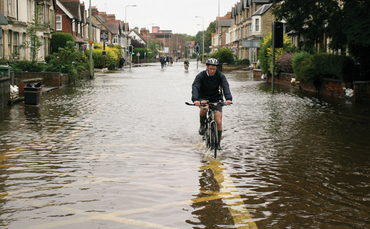

National Infrastructure Commission warns over 600,000 homes and businesses are at risk without improved action to tackle runoff
Flooded streets, homes, and stations could become a common feature of city life without urgent action to tackle the growing risk of surface water flooding triggered by increasingly intense rainfall.
That is the stark warning contained in a major new report from the National Infrastructure Commission, which warns a combination of more intense rainfall driven by climate change and poorly planned urban development without sufficient drainage could see the number of properties at risk from surface water flooding.
The report highlights how last year a series of storms overwhelmed drains in London, resulting in the flooding of 1,500 properties and several Tube stations.
It warns that currently 325,000 homes and businesses in England are deemed to be at high risk from surface water flooding, meaning they have a 60 per cent chance of being flooded in the next thirty years. But it adds that without urgent action new development and climate change impacts will result in the number of properties at high risk almost doubling to 600,000.
The report said that climate risks and increasing pressure on drainage systems from new developments could push an additional 230,000 properties into the high risk category by 2055, while the spread of impermeable surfaces - such as the paving over of gardens - could move another 65,000 properties into a high risk area.
National Infrastructure Commissioner Professor Jim Hall said it was "clear that faced with more intense rainfall and increased urbanisation, we need to start taking this type of flooding far more seriously".
However, the report argues the risk of surface water flooding can be significantly reduced through a combination of investment in improved drainage and flood management systems and governance and planning reforms.
"Action to expand existing drainage capacity above and below ground, including the use of nature-based solutions such as green gulleys and flood storage ponds, and addressing the fragmented way in which the problem is managed and funded, will improve the resilience of drainage systems to more frequent and heavier downpours," the report states.
The Commission estimates £12bn of investment over 30 years is required in the new drainage infrastructure. But it adds that this bill could be reduced as a result of action undertaken through the planned £56bn of investment already earmarked to reduce sewer overflow spills.
"The solution is clear - reducing the amount of water flowing into drains, whilst also improving the capacity of those drains," said Hall. "That means stopping urban creep from increasing the amount of storm water that drainage systems have to cope with and giving nature more opportunities to hold on to excess water, as well as targeted investment to ensure sewers can cope with growing pressures.
"While sustained investment is needed, the estimated additional costs are relatively modest. At least as important is a more joined-up approach to owning and acting on the problem."
As such, the report argues that the Environment Agency should be actively involved in assessing surface water flood risk and government should set national risk reduction targets. It adds that local authorities and water companies should then work together to develop fully costed joint plans which deliver locally agreed targets, with public funding devolved to local areas.
The intervention is the latest in a string of reports arguing the UK's climate resilience plans remain badly insufficient in the face of escalating climate-related risks.
It also comes as the government faces a growing backbench rebellion against plans for new housing targets, with the rebels arguing that too many new developments are being delivered without sufficient attention paid to the resulting impact on drainage systems, water tables, and flood risks.
Defra was considering a request for comment at the time of going to press.
* This article was originally published here
Comments
Post a Comment